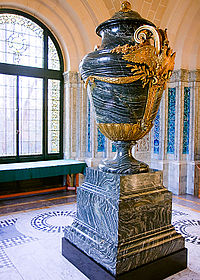 |
| The Peace Palace, pictured in March 2006 |
(Dutch: Vredespaleis) is a building incalled the seat of international law because it houses the International Court of Justice (which is the principal judicial body of the United Nations), the Permanent Court of Arbitration, the Hague Academy of International Law, and the extensive Peace Palace Library.
In addition to hosting these institutions, the Palace is also a regular venue for special events in international policy and law. The Palace officially opened on August 28, 1913, and was originally built to provide a symbolic home for the Permanent Court of Arbitration, a court created to end war which was created by treaty at the 1899 Hague Peace Conference. Andrew Dickson White, whose efforts were instrumental in creating this court and securing the funding to provide it with a "worthy accommodation", wrote of the idea to his friend Andrew Carnegie, who eventually provided 1.5 million dollars to build the Peace Palace:
“A temple of peace where the doors are open, in contrast to the Janus-temple, in times of peace and closed in cases of war (…..) as a worthy testimony of the people that, after many long centuries finally a court that has thrown open its doors for the peaceful settlement of differences between peoples”.
- Were such a fabric to be created, men would make pilgrimages from all parts of the civilized world to see it. It would become a sort of holy place, prized and revered by thinking men throughout the world, and to which, in any danger of war between any two countries, the minds of men would turn naturally and normally. The main difficulty now is that the people of the various nations do not really know what was done for them by the Conference; but such a building would make them know it. It would be an "outward and visible sign" of the Court, which would make its actual, tangible existence known to the ends of the earth" - Andrew Dickson White to Andrew Carnegie, August 5th, 1902
 |
| Vase offered by Russia |
Conception
The idea of the Palace started from a discussion in 1900 between the Russian diplomat Friedrich Martens and the US diplomat Andrew White, over providing a home for the Permanent Court of Arbitration (PCA), which was established through the first Hague Peace Conference in 1899. White contacted his friend the philanthropist Andrew Carnegie about this idea. Carnegie had his reservations, and at first was only interested in donating money for the establishment of a Library of International Law. White however was able to convince Carnegie, and in 1903 Carnegie agreed to donate the US$1.5 million ($40,000,000, adjusted for inflation) needed for a Peace Temple that would house the PCA as well as to endow it with a library of international law.
At first Carnegie simply wanted to donate the money directly to the Dutch Queen, Wilhelmina of the Netherlands for the building of the palace, but legal problems prohibited this, and in November 1903 the Carnegie Stichting was founded to manage the construction, ownership, and maintenance of the Palace. This foundation is still responsible for these issues at present.
Construction
 |
| Carnegie and the original map of the Peace Palace |
In 1908 Thomas Hayton Mawson won a competition to design the grounds. Because of the budget constraints, he also had to discard design elements—fountains and sculptures. Hew made use of a natural watercourse on the site.
The Palace is filled with many gifts of the different nations who attended the Second Hague Conference as a sign of their support. Among the gifts are a 3.2-tonne (3.1-long-ton; 3.5-short-ton) vase from Russia, doors from Belgium, marble from Italy, a fountain from Denmark, wall carpets from Japan, the clock for the clock tower from Switzerland, Persian rugs from Iran and wood from Indonesia and the United States of America. The palace also features a number of statues, busts and portraits of prominent peace campaigners from around the world and of all eras.
In 1907 the first stone was symbolically placed during the Second Hague Conference. The construction began some months later and was completed
In 1999 an eternal peace flame was installed in front of its gates.
In 2007, Queen Beatrix opened the new building for the Peace Palace Library of International Law, housing the entire catalogue of the library, a lecture hall and a new reading room in the bridge to the main building of the Peace Palace. Like the new Academy Hall, the library was designed by architects Michael Wilford and Manuel Schupp.
Reference: http://en.wikipedia.org/wiki/Peace_Palace



No comments:
Post a Comment